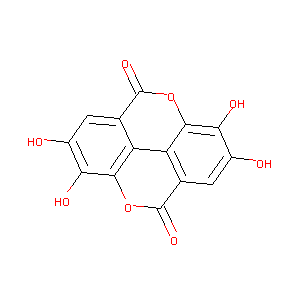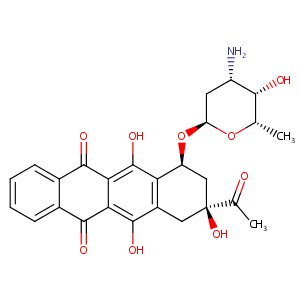| DOT Name |
DOT ID |
UniProt ID |
Mode of Action |
REF |
|
DNA fragmentation factor subunit alpha (DFFA)
|
OTFPFMT8
|
DFFA_HUMAN
|
Decreases Expression
|
[5] |
|
Nucleolar protein 56 (NOP56)
|
OTT67SRZ
|
NOP56_HUMAN
|
Decreases Expression
|
[5] |
|
Apoptotic protease-activating factor 1 (APAF1)
|
OTJWIVY0
|
APAF_HUMAN
|
Decreases Expression
|
[5] |
|
Glutathione S-transferase A4 (GSTA4)
|
OTZ1USIA
|
GSTA4_HUMAN
|
Increases Expression
|
[5] |
|
Regulator of G-protein signaling 5 (RGS5)
|
OTUY0Q2I
|
RGS5_HUMAN
|
Decreases Expression
|
[5] |
|
Transforming growth factor beta-1 proprotein (TGFB1)
|
OTV5XHVH
|
TGFB1_HUMAN
|
Increases Expression
|
[5] |
|
Prostate-specific antigen (KLK3)
|
OTFGSBFJ
|
KLK3_HUMAN
|
Decreases Expression
|
[5] |
|
Asparagine synthetase (ASNS)
|
OT8R922G
|
ASNS_HUMAN
|
Increases Expression
|
[5] |
|
Extracellular superoxide dismutase (SOD3)
|
OTIOZQAB
|
SODE_HUMAN
|
Decreases Expression
|
[5] |
|
Fibroblast growth factor receptor 1 (FGFR1)
|
OT4GLCXW
|
FGFR1_HUMAN
|
Decreases Expression
|
[5] |
|
Prostatic acid phosphatase (ACP3)
|
OTSIM0YG
|
PPAP_HUMAN
|
Increases Expression
|
[5] |
|
Insulin-like growth factor-binding protein 2 (IGFBP2)
|
OTG1P60E
|
IBP2_HUMAN
|
Increases Expression
|
[5] |
|
Cyclic AMP-dependent transcription factor ATF-3 (ATF3)
|
OTC1UOHP
|
ATF3_HUMAN
|
Increases Expression
|
[5] |
|
Pleiotrophin (PTN)
|
OTYC7M2A
|
PTN_HUMAN
|
Decreases Expression
|
[5] |
|
Filamin-A (FLNA)
|
OTYZ9JXM
|
FLNA_HUMAN
|
Decreases Expression
|
[5] |
|
Bone morphogenetic protein 6 (BMP6)
|
OT9WN536
|
BMP6_HUMAN
|
Decreases Expression
|
[5] |
|
Insulin-like growth factor-binding protein 4 (IGFBP4)
|
OT2HZRBD
|
IBP4_HUMAN
|
Decreases Expression
|
[5] |
|
Calreticulin (CALR)
|
OTYD2TR1
|
CALR_HUMAN
|
Decreases Expression
|
[5] |
|
Transcription initiation factor IIE subunit beta (GTF2E2)
|
OTDHCCCR
|
T2EB_HUMAN
|
Increases Expression
|
[5] |
|
Protein PML (PML)
|
OT6SM2GD
|
PML_HUMAN
|
Decreases Expression
|
[5] |
|
Epidermal growth factor receptor substrate 15 (EPS15)
|
OT7NPP8U
|
EPS15_HUMAN
|
Increases Expression
|
[5] |
|
Caspase-3 (CASP3)
|
OTIJRBE7
|
CASP3_HUMAN
|
Decreases Expression
|
[5] |
|
Achaete-scute homolog 1 (ASCL1)
|
OTI4X44G
|
ASCL1_HUMAN
|
Increases Expression
|
[5] |
|
GTP-binding nuclear protein Ran (RAN)
|
OT2TER5M
|
RAN_HUMAN
|
Decreases Expression
|
[5] |
|
Microtubule-associated protein 1A (MAP1A)
|
OTHO8K43
|
MAP1A_HUMAN
|
Decreases Expression
|
[5] |
|
Phosphatidylinositol-glycan-specific phospholipase D (GPLD1)
|
OTUUQOVY
|
PHLD_HUMAN
|
Decreases Expression
|
[5] |
|
Transcription factor A, mitochondrial (TFAM)
|
OTXXV5V7
|
TFAM_HUMAN
|
Decreases Expression
|
[5] |
|
Nuclear factor NF-kappa-B p100 subunit (NFKB2)
|
OTS231V7
|
NFKB2_HUMAN
|
Decreases Expression
|
[5] |
|
Interferon regulatory factor 9 (IRF9)
|
OTK4MYQJ
|
IRF9_HUMAN
|
Increases Expression
|
[5] |
|
Peroxisome proliferator-activated receptor delta (PPARD)
|
OTI4WTOP
|
PPARD_HUMAN
|
Decreases Expression
|
[5] |
|
Transcription factor p65 (RELA)
|
OTUJP9CN
|
TF65_HUMAN
|
Decreases Expression
|
[5] |
|
Proteolipid protein 2 (PLP2)
|
OTEZ4LOV
|
PLP2_HUMAN
|
Increases Expression
|
[5] |
|
Early growth response protein 3 (EGR3)
|
OTGPJIRA
|
EGR3_HUMAN
|
Decreases Expression
|
[5] |
|
Histone acetyltransferase p300 (EP300)
|
OTL8QJDX
|
EP300_HUMAN
|
Increases Expression
|
[5] |
|
Ras GTPase-activating-like protein IQGAP2 (IQGAP2)
|
OTX2UA7P
|
IQGA2_HUMAN
|
Increases Expression
|
[5] |
|
cGMP-dependent protein kinase 1 (PRKG1)
|
OTPAS4LF
|
KGP1_HUMAN
|
Decreases Expression
|
[5] |
|
Septin-2 (SEPTIN2)
|
OT3G33TM
|
SEPT2_HUMAN
|
Increases Expression
|
[5] |
|
Monocyte to macrophage differentiation factor (MMD)
|
OTB5I4OC
|
PAQRB_HUMAN
|
Increases Expression
|
[5] |
|
TATA box-binding protein-associated factor RNA polymerase I subunit C (TAF1C)
|
OTNV4CDH
|
TAF1C_HUMAN
|
Decreases Expression
|
[5] |
|
Neuronatin (NNAT)
|
OTNRLO7G
|
NNAT_HUMAN
|
Increases Expression
|
[5] |
|
Hypoxia-inducible factor 1-alpha (HIF1A)
|
OTADSC03
|
HIF1A_HUMAN
|
Decreases Expression
|
[5] |
|
Transcription factor E4F1 (E4F1)
|
OTL5ESAC
|
E4F1_HUMAN
|
Increases Expression
|
[5] |
|
General transcription factor IIH subunit 4 (GTF2H4)
|
OTPD1DIU
|
TF2H4_HUMAN
|
Increases Expression
|
[5] |
|
Histone-lysine N-methyltransferase EZH1 (EZH1)
|
OTFLUU94
|
EZH1_HUMAN
|
Increases Expression
|
[5] |
|
Phosphatidylinositol 3,4,5-trisphosphate 5-phosphatase 1 (INPP5D)
|
OT7I3U0G
|
SHIP1_HUMAN
|
Increases Expression
|
[5] |
|
Receptor-type tyrosine-protein phosphatase N2 (PTPRN2)
|
OTL6SH28
|
PTPR2_HUMAN
|
Increases Expression
|
[5] |
|
Transcription factor IIIB 90 kDa subunit (BRF1)
|
OTQC6DMG
|
TF3B_HUMAN
|
Decreases Expression
|
[5] |
|
Transcription factor 12 (TCF12)
|
OTZVONNU
|
HTF4_HUMAN
|
Increases Expression
|
[5] |
|
Lipopolysaccharide-induced tumor necrosis factor-alpha factor (LITAF)
|
OTT5JX1F
|
LITAF_HUMAN
|
Increases Expression
|
[5] |
|
Neuronal PAS domain-containing protein 2 (NPAS2)
|
OTMRT2TS
|
NPAS2_HUMAN
|
Increases Expression
|
[5] |
|
Immediate early response gene 2 protein (IER2)
|
OT5OY8BO
|
IER2_HUMAN
|
Increases Expression
|
[5] |
|
Autophagy protein 5 (ATG5)
|
OT4T5SMS
|
ATG5_HUMAN
|
Increases Expression
|
[5] |
|
Death domain-associated protein 6 (DAXX)
|
OTX6O7PL
|
DAXX_HUMAN
|
Decreases Expression
|
[5] |
|
Poly(ADP-ribose) glycohydrolase (PARG)
|
OT10JTIO
|
PARG_HUMAN
|
Decreases Activity
|
[11] |
|
Stearoyl-CoA desaturase (SCD)
|
OTB1073G
|
SCD_HUMAN
|
Decreases Expression
|
[12] |
|
Interleukin-1 beta (IL1B)
|
OT0DWXXB
|
IL1B_HUMAN
|
Decreases Expression
|
[12] |
|
Cytochrome P450 1A1 (CYP1A1)
|
OTE4EFH8
|
CP1A1_HUMAN
|
Decreases Expression
|
[12] |
|
Monocyte differentiation antigen CD14 (CD14)
|
OT83GJ47
|
CD14_HUMAN
|
Decreases Expression
|
[12] |
|
C-C motif chemokine 2 (CCL2)
|
OTAD2HEL
|
CCL2_HUMAN
|
Decreases Secretion
|
[12] |
|
Phospholipase A2, membrane associated (PLA2G2A)
|
OT1NY7BF
|
PA2GA_HUMAN
|
Decreases Expression
|
[12] |
|
Interleukin-1 receptor type 1 (IL1R1)
|
OTTU8959
|
IL1R1_HUMAN
|
Decreases Expression
|
[12] |
|
Signal transducer and activator of transcription 3 (STAT3)
|
OTAAGKYZ
|
STAT3_HUMAN
|
Decreases Expression
|
[12] |
|
Heme oxygenase 1 (HMOX1)
|
OTC1W6UX
|
HMOX1_HUMAN
|
Increases Expression
|
[13] |
|
NAD(P)H dehydrogenase 1 (NQO1)
|
OTZGGIVK
|
NQO1_HUMAN
|
Increases Expression
|
[13] |
|
Telomerase reverse transcriptase (TERT)
|
OT085VVA
|
TERT_HUMAN
|
Increases Expression
|
[14] |
|
Apoptosis-inducing factor 1, mitochondrial (AIFM1)
|
OTKPWB7Q
|
AIFM1_HUMAN
|
Increases Expression
|
[6] |
|
Reversion-inducing cysteine-rich protein with Kazal motifs (RECK)
|
OT9QIHEQ
|
RECK_HUMAN
|
Increases Expression
|
[15] |
|
Coagulation factor XII (F12)
|
OTBFD2FU
|
FA12_HUMAN
|
Increases Activity
|
[16] |
|
Tumor necrosis factor (TNF)
|
OT4IE164
|
TNFA_HUMAN
|
Decreases Expression
|
[17] |
|
Albumin (ALB)
|
OTVMM513
|
ALBU_HUMAN
|
Affects Binding
|
[18] |
|
Cellular tumor antigen p53 (TP53)
|
OTIE1VH3
|
P53_HUMAN
|
Increases Expression
|
[17] |
|
Transcription factor Jun (JUN)
|
OTCYBO6X
|
JUN_HUMAN
|
Decreases Expression
|
[19] |
|
Cyclin-dependent kinase 1 (CDK1)
|
OTW1SC2N
|
CDK1_HUMAN
|
Decreases Expression
|
[6] |
|
72 kDa type IV collagenase (MMP2)
|
OT5NIWA2
|
MMP2_HUMAN
|
Decreases Expression
|
[17] |
|
Interleukin-8 (CXCL8)
|
OTS7T5VH
|
IL8_HUMAN
|
Decreases Expression
|
[17] |
|
Apoptosis regulator Bcl-2 (BCL2)
|
OT9DVHC0
|
BCL2_HUMAN
|
Decreases Expression
|
[17] |
|
Glucose-6-phosphate 1-dehydrogenase (G6PD)
|
OT300SMK
|
G6PD_HUMAN
|
Decreases Activity
|
[20] |
|
Matrix metalloproteinase-9 (MMP9)
|
OTB2QDAV
|
MMP9_HUMAN
|
Decreases Expression
|
[17] |
|
RAC-alpha serine/threonine-protein kinase (AKT1)
|
OT8H2YY7
|
AKT1_HUMAN
|
Increases Phosphorylation
|
[21] |
|
Nitric oxide synthase, inducible (NOS2)
|
OTKKIOJ1
|
NOS2_HUMAN
|
Decreases Expression
|
[17] |
|
Peroxisome proliferator-activated receptor gamma (PPARG)
|
OTHMARHO
|
PPARG_HUMAN
|
Increases Expression
|
[19] |
|
Cyclin-dependent kinase inhibitor 1 (CDKN1A)
|
OTQWHCZE
|
CDN1A_HUMAN
|
Increases Expression
|
[6] |
|
Biotin--protein ligase (HLCS)
|
OTPDUX30
|
BPL1_HUMAN
|
Decreases Activity
|
[22] |
|
6-phosphogluconate dehydrogenase, decarboxylating (PGD)
|
OTVG296F
|
6PGD_HUMAN
|
Decreases Activity
|
[20] |
|
Apoptosis regulator BAX (BAX)
|
OTAW0V4V
|
BAX_HUMAN
|
Increases Expression
|
[17] |
|
Mitogen-activated protein kinase kinase kinase 1 (MAP3K1)
|
OTS3FVTY
|
M3K1_HUMAN
|
Decreases Expression
|
[19] |
|
Endonuclease G, mitochondrial (ENDOG)
|
OT5IM7B3
|
NUCG_HUMAN
|
Increases Expression
|
[6] |
|
Nuclear receptor subfamily 1 group I member 3 (NR1I3)
|
OTS3SGH7
|
NR1I3_HUMAN
|
Increases Activity
|
[23] |
|
Mitogen-activated protein kinase 11 (MAPK11)
|
OT0AS010
|
MK11_HUMAN
|
Increases Expression
|
[19] |
|
Nuclear factor erythroid 2-related factor 2 (NFE2L2)
|
OT0HENJ5
|
NF2L2_HUMAN
|
Increases Expression
|
[24] |
|
DNA oxidative demethylase ALKBH2 (ALKBH2)
|
OTSQW0BG
|
ALKB2_HUMAN
|
Decreases Activity
|
[25] |
|
Bcl2-associated agonist of cell death (BAD)
|
OT63ERYM
|
BAD_HUMAN
|
Increases Expression
|
[6] |
| ------------------------------------------------------------------------------------ |
|
|
|
|


